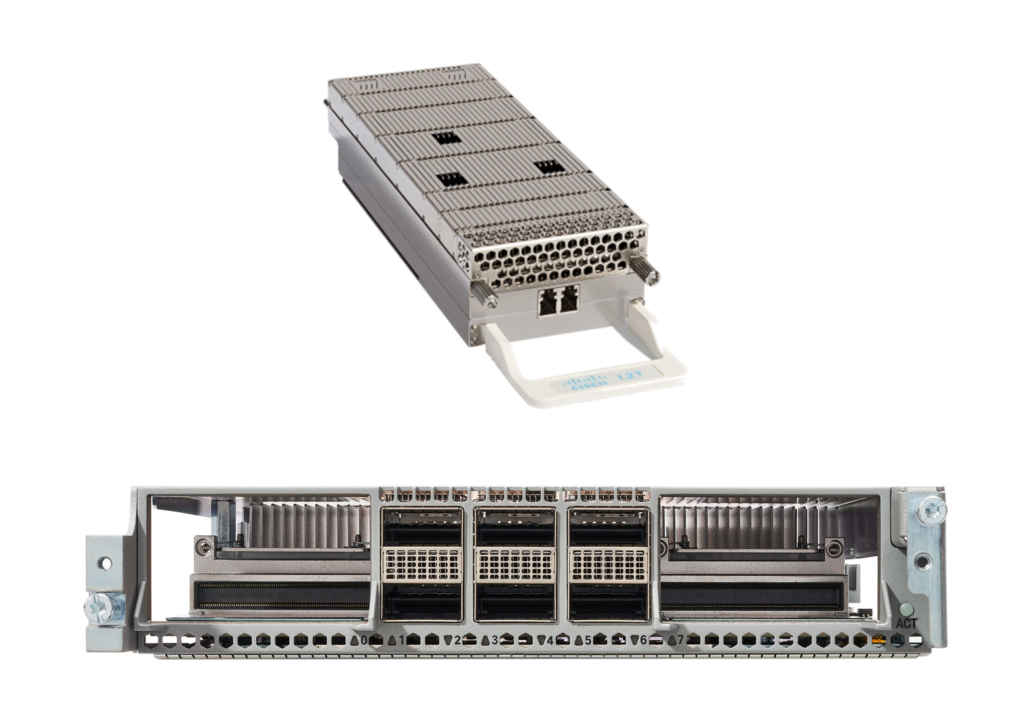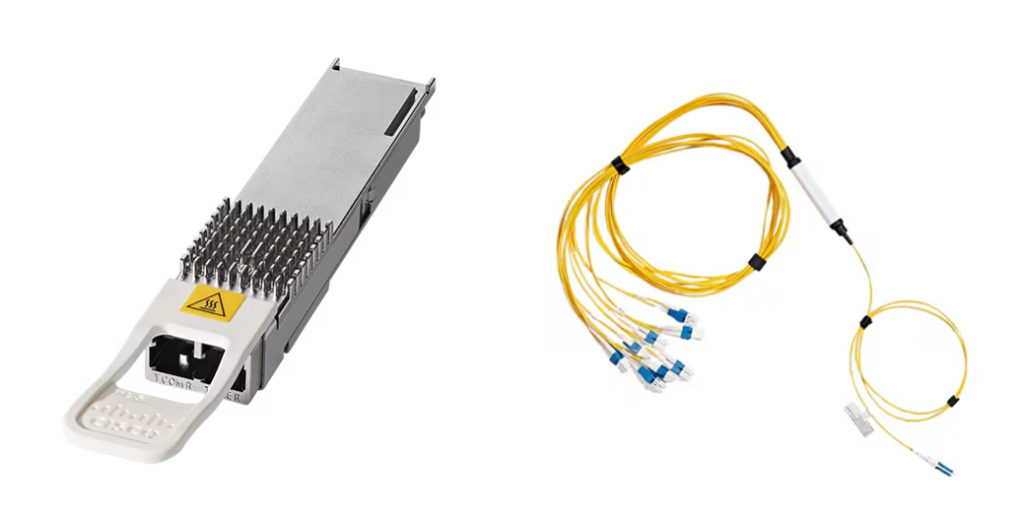
Cignal AI attended Cisco’s annual Packet Optical Networking Conference (PONC) at its optical headquarters in Richardson, TX on September 18th and 19th. The well-attended event featured customer testimonials, product and technology updates, and live demonstrations.
Routed Optical Networking Goes Mainstream
Since its introduction more than five years ago and catalyzed by the acquisition of pluggable coherent optics pioneer Acacia, Cisco’s Routed Optical Networking architecture (aka RON) has become the centerpiece of the company’s transport messaging. In previous years’ PONCs, much of the content was devoted to reintroducing what is commonly known as IP-over-DWDM to a skeptical audience wary of the operational headaches and compromised performance that historically accompanied router-hosted DWDM optics.
While Cisco gave assurances that those obstacles would be overcome, RON promised more than just space and power savings, but a complete reimagining of the way transport (routing + optical) networks are built. Massive router capacity combined with pluggable coherent optics would collapse layers 0 to 3, and Service Provider network architectures would follow suit with router- and optics-intensive topologies, obviating the need for a highly complex optical layer and the dedicated equipment it requires.
Over the intervening years, that messaging has softened, bowing to the reality that is the glacial pace at which service providers change. But the enabling technologies haven’t stood still. In fact, they’ve moved faster than almost anyone could have anticipated when RON was introduced alongside the 400ZR standard around 2020. If you had claimed at the time that 400ZR+ optics would reach more than 1000km over brownfield networks – and that by 2024 800ZR+ optics, still in a QSFP-DD form factor, would perform even better, few would have believed you. By 2027, pluggable optics will account for half of the total coherent market.

"*" indicates required fields
While the benefits of RON and its operational trade-offs continue to spark debate, the power (and space) savings from router-hosted coherent optics are undeniable. Corporate commitments to sustainability aren’t a fad. Efforts to minimize power consumption are paramount and permanent, and sustainability is a differentiator for companies who are at the forefront of integrating it into their products. In PONC’s kickoff presentation, Buddy Bayer, COO of innovative service provider (and early RON adopter) COLT, cited the operator’s ability to calculate the power consumption and carbon footprint of the individual telecom services it offers. Such insight gives customers the choice of routing services around high carbon countries such as Germany in favor of ones with lower carbon grids such as France. No amount of handwringing over organizational and operational hurdles can minimize the reality that router-hosted optics are significantly more space and power-efficient than transponders (even when those transponders use pluggable coherent optics themselves).
Traditional Optical Transport
There’s no doubt that Cisco is all-in on Routed Optical Networking; it paid $4.5B for Acacia and continues to lead the global routing market. But what about traditional optical transport based on transponders and ROADMs? Having skipped the Gen90 / 800G generation of embedded coherent optics and arriving late-to-market with a disaggregated, compact modular, C+L line system, Cisco is emerging from a period during which many questioned its commitment to optical networking. Cisco used this year’s PONC to allay such concerns by demonstrating a roadmap which complements RON while maintaining the company’s competitiveness as a vendor of traditional optical transport gear.
Acacia’s Coherent Interconnect Module (CIM) 8 module began shipping in volume over the past several quarters. Unlike those of competitors Nokia and Ciena, Cisco’s newest high performance coherent interface requires an updated compact modular chassis, the NCS 1014. This new platform is required for the 2.4T transponder line card (which hosts two CIM 8’s) yet maintains backwards compatibility with line cards from the previous generation NCS 1004. The CIM-8 has been featured in numerous public trials and live demonstrations. At PONC, Australian NREN AARNet presented its trials of CIM 8 over record-breaking distances as well as its legacy NCS 2000 terrestrial line system. A live lab demonstration featured CIM 8 terabit wavelengths over a 1300km C+L line system with a fully loaded capacity of 64Tb/s.
CIM 8 keeps Cisco relevant in the subsea market, where it has found some success with a line card based on the Gen60P Acacia AC1200 performance optimized embedded module. A subsea trial with Microsoft was conducted earlier this year. The CIM 8 was the first Gen120P (120+ GBaud, Performance-optimized) product to be announced and one of the first to ship, but it joins a crowded field which includes Nokia, Fujitsu, Huawei, and ZTE. Hyperscalers are certain to stick with Ciena, which will again leapfrog the industry with its Gen180P WaveLogic 6e later this year. Provided Ciena executes, the battle is on for who will be the second source vendor for long haul WDM at hyperscalers. Cisco has strong relationships with hyperscalers but will face a reinvigorated Nokia/Infinera combination. In general, it remains to be seen whether the CIM 8 will be a differentiator or simply meet table stakes in today’s optical marketplace.

Perhaps more impactful on Cisco’s optical networking fortunes than CIM-8 will be Acacia’s 800ZR+ module. Demonstrated at PONC alongside CIM-8 over the same 1300km C+L line system, the Gen120C (120+ Gigabaud, Compact) optic is close to shipping. This would make it first to market among modules supporting interoperable Probabilistic Constellation Shaping (PCS) defined by OpenROADM (Lumentum’s and others’ modules based on Marvell’s DSP use a proprietary PCS). The Acacia module is certain to be deployed by hyperscalers in IP-over-DWDM Metro/Regional DCI applications, and perhaps even Long Haul, but its impact on the Service Provider landscape will most likely come as the line side optic within a transponder. 800G-capable routers will take time to proliferate, but in the meantime, carriers can take advantage of the power and cost advantages of 800ZR+ within pluggable transponders (a category increasing in popularity with high-power 400ZR+ optics). Cisco did not announce or demonstrate such a transponder, but indicated that it’s on the roadmap for the NCS 1014, and will likely resemble the currently shipping 3.2T High-Density QSFP-DD Transponder which uses 400ZRx optics.
Cisco also highlighted its unique 400G ULH (not to be called 400ZR++) QSFP-DD module which leverages the same Delphi DSP and 130GBaud operation of its 800ZR+ sibling but maintains backwards compatibility with 400G hosts. The module enables 400G transmission of up to 3000km in 130GBaud mode or 2000km within a 100GHz channel by decreasing the baud rate and dialing up the spectral efficiency using PCS. Such performance is on par with Gen90P embedded optics such as Ciena’s WaveLogic 5e and Infinera’s ICE-6, which is a remarkable achievement by a pluggable optic.
In addition to its 400ZRx optics, Acacia highlighted the overall breadth of its optics portfolio, including 400ER1 (40km non-DWDM), 400G CFP2 Bidi (single fiber operation), as well as 100ZR QSFP-DD and QSFP modules (the latter certainly sourced from Coherent). Acacia also touched upon the promise of the OIF’s newly issued CMIS 5.3, and how its support for an application descriptor (AppSel) code opens up the possibility of host-independent pluggable configuration. A new OIF white paper jointly authored by Cisco and Ciena outlines the new capabilities which advance the industry, perhaps reluctantly, toward the vision of “any plug in any host” compatibility.
Line Systems
Cisco boasts over 200 RON customers; a count which has grown YoY every quarter for the past two years. 70% of RON deployments are over third-party line systems, which reminds us that while RON has become synonymous with Cisco’s optical business, it’s Cisco routers (plus Acacia optics) that define what a RON network is. This ratio makes sense given the relative market shares of the two businesses – 5% for optical versus 40% for routing (Worldwide ex-China). Yet in another sense, the fact that Cisco line systems are used in nearly a third of RON wins shows that offering a complete IP+Optical transport solution is important to the architecture’s success.
Cisco was an early market leader in ROADMs more than a decade ago but fell behind as the industry shifted to disaggregated line systems supporting the C and L bands. With investment in the ONS 15454 / NCS 2000 effectively capped, Cisco finally released the NCS 1010 Compact Modular Open Line System in 2023. Since then, the platform has matured to offer additional variants including the NCS 1012, which can host both C and L band WSS modules in a single chassis, and the NCS 1020, which supports colorless add/drop modules as well. This product maturation should allow Cisco to compete once again for hyperscale and carrier Long Haul infrastructure; a market that it ceded to Ciena, Nokia, and Infinera over the past several years.

Cisco used PONC this year to introduce the NCS 1014 Metro DCI Open Line System. Hosted in the same Compact Modular chassis used for transponder cards, the new system introduces modern features such as OTDR, OSC, link performance probe, and automated turnup and power control into a “lower-end” Metro-focused platform ideal for RON deployments. It relies upon external passive multiplexers but can also host colorless modules internally. As one would expect, it’s an OLS designed around pluggable coherent, capable of being turned up without co-located optics by leveraging connection verification and noise loading for that purpose. It also adheres to a different economic model than traditional line systems, which are sold at a discount with margin recovery provided by more profitable transponders. In the new era of open line systems and router-hosted optics, line systems increasingly need to stand on their own as profitable product lines. It’s expected to ship in 1Q25.
While the venerable NCS 2000 is no longer receiving significant hardware upgrades, Cisco reminded its customers at the event that the platform represents more than $6 billion worth of installed base, and that the company guarantees its ongoing support to at least 2035 (Cisco has issued similar assurances in the past for widely deployed but aging routers such as the 7600). One issue addressed was the preponderance of fixed grid ROADMs, particularly 50GHz ROADMs which are no longer compatible with modern wavelengths. To these customers, Cisco proposes upgrading to its 20-degree Flex Spectrum ROADM, which continues to be supported within the NCS 2000. Cisco was among the first to support what were then referred to as “alien wavelengths”, and so these systems, despite their age, are fully capable of operating as open line systems and are often deployed that way.
Lastly, for router-to-router RON deployments or point-to-point DCI networks truly free of dedicated optical transport hardware, Cisco offers the Pluggable Open Line System which was originally developed by II-VI (now Coherent) several years ago. Fitting into a QSFP-DD and hosted in a router port, the module has progressed from the original, and now incorporates high-power variable gain booster and pre-amplifiers. It supports up to 16 channels using a breakout cable or 32 channels with an external mux/demux.

Conclusion
400ZRx has already conquered the massive market for hyperscale Metro DCI, and 800ZRx is predicted to make significant inroads into their regional and long haul networks. By 2028, Cignal AI forecasts that over 750,000 pluggable coherent optics will be deployed in IP-over-DWDM applications annually, with over 100,000 of those destined for service providers.
At Cisco’s 2024 PONC, RON’s messaging around a complete rethink of network architectures remained but wasn’t over-emphasized. One didn’t hear the term “hop-by-hop”, or much about eliminating optical bypass. The ability to do that and the potential cost savings are implied by RON, but Cisco is careful not to force it down your throat. However, this isn’t because Cisco has given up on its vision, or that customers are turned off by it. Instead, with more than 200 customer wins under its belt and nearly every other optical and routing vendor touting its pluggable capabilities, there seems to be a growing sense that the widespread adoption of router-hosted coherent optics is inevitable, whether accompanied by a fundamental change in network architecture or not.
